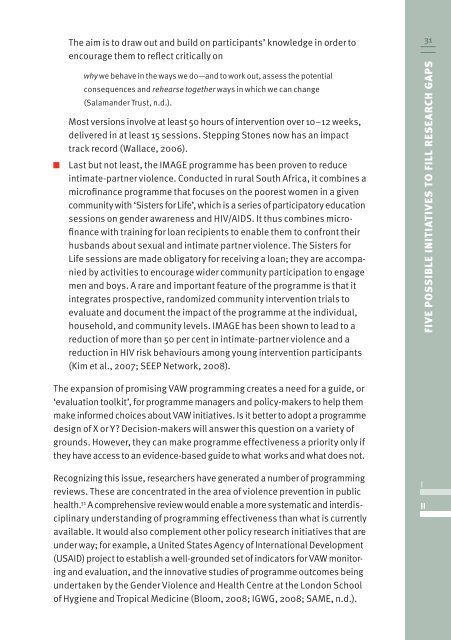Tackling Violence against Women: From Knowledge to Practical
Tackling Violence against Women: From Knowledge to Practical
Tackling Violence against Women: From Knowledge to Practical
Create successful ePaper yourself
Turn your PDF publications into a flip-book with our unique Google optimized e-Paper software.
The aim is <strong>to</strong> draw out and build on participants’ knowledge in order <strong>to</strong><br />
encourage them <strong>to</strong> reflect critically on<br />
why we behave in the ways we do—and <strong>to</strong> work out, assess the potential<br />
consequences and rehearse <strong>to</strong>gether ways in which we can change<br />
(Salamander Trust, n.d.).<br />
Most versions involve at least 50 hours of intervention over 10–12 weeks,<br />
delivered in at least 15 sessions. Stepping S<strong>to</strong>nes now has an impact<br />
track record (wallace, 2006).<br />
Last but not least, the IMAgE programme has been proven <strong>to</strong> reduce<br />
intimate-partner violence. Conducted in rural South Africa, it combines a<br />
microfinance programme that focuses on the poorest women in a given<br />
community with ‘Sisters for Life’, which is a series of participa<strong>to</strong>ry education<br />
sessions on gender awareness and HIV/AIDS. It thus combines microfinance<br />
with training for loan recipients <strong>to</strong> enable them <strong>to</strong> confront their<br />
husbands about sexual and intimate partner violence. The Sisters for<br />
Life sessions are made obliga<strong>to</strong>ry for receiving a loan; they are accompanied<br />
by activities <strong>to</strong> encourage wider community participation <strong>to</strong> engage<br />
men and boys. A rare and important feature of the programme is that it<br />
integrates prospective, randomized community intervention trials <strong>to</strong><br />
evaluate and document the impact of the programme at the individual,<br />
household, and community levels. IMAgE has been shown <strong>to</strong> lead <strong>to</strong> a<br />
reduction of more than 50 per cent in intimate-partner violence and a<br />
reduction in HIV risk behaviours among young intervention participants<br />
(kim et al., 2007; SEEp Network, 2008).<br />
The expansion of promising VAw programming creates a need for a guide, or<br />
‘evaluation <strong>to</strong>olkit’, for programme managers and policy-makers <strong>to</strong> help them<br />
make informed choices about VAw initiatives. Is it better <strong>to</strong> adopt a programme<br />
design of X or Y? Decision-makers will answer this question on a variety of<br />
grounds. However, they can make programme effectiveness a priority only if<br />
they have access <strong>to</strong> an evidence-based guide <strong>to</strong> what works and what does not.<br />
Recognizing this issue, researchers have generated a number of programming<br />
reviews. These are concentrated in the area of violence prevention in public<br />
health. 31 A comprehensive review would enable a more systematic and interdisciplinary<br />
understanding of programming effectiveness than what is currently<br />
available. It would also complement other policy research initiatives that are<br />
under way; for example, a United States Agency of International Development<br />
(USAID) project <strong>to</strong> establish a well-grounded set of indica<strong>to</strong>rs for VAw moni<strong>to</strong>ring<br />
and evaluation, and the innovative studies of programme outcomes being<br />
undertaken by the gender <strong>Violence</strong> and Health Centre at the London School<br />
of Hygiene and Tropical Medicine (Bloom, 2008; Igwg, 2008; SAME, n.d.).<br />
31<br />
FiVE PossiBlE iNiTiATiVEs To Fill REsEARcH GAPs<br />
i<br />
ii









